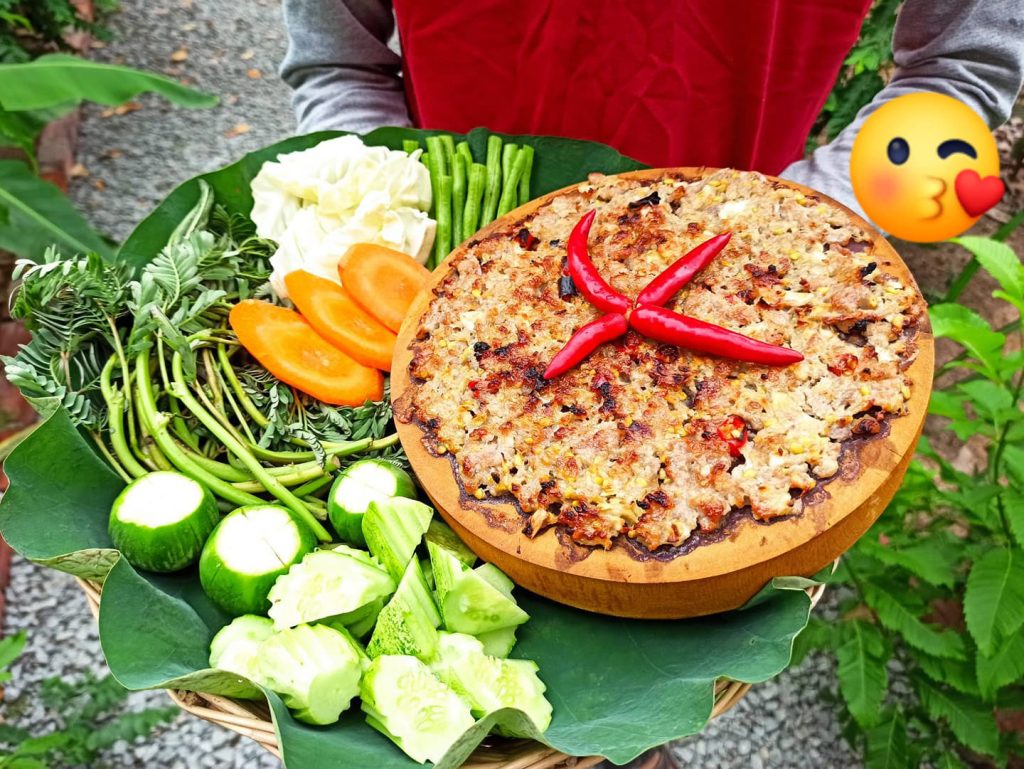Cambodia’s culinary tapestry is woven with a rich history and diverse flavors that reflect the country’s cultural heritage. At the heart of Cambodian cuisine lies a deep appreciation for preservation techniques that extend the shelf life of ingredients and infuse them with unique and delectable flavors. From fermented delicacies to dried meats and tangy pickles, let’s explore and savor the best-preserved foods that exemplify Cambodia’s culinary prowess.
List of The Best Preserved Foods in Cambodia
Here are some of the best-preserved foods in Cambodia you should know:
1. Fermented Fish (Prahok & Pa’ak)
Fermented fish, notably Prahok and Pa’ak, are iconic Cambodian ingredients that are the backbone of many dishes. Prahok, a pungent and powerful paste made from salted and fermented fish, adds depth and umami to soups and stir-fries. Pa’ak is a milder version of fermented fish, used to create delightful dips and sauces that showcase the country’s mastery of preservation.

Best Preserved Foods In Cambodia (Prahok Ang From អាហារដ្ឋានកញ្ចុះឬស្សី )
- Cultural Significance: Prahok is deeply rooted in Cambodian culture and history. It has been a staple of Cambodian cuisine for centuries and is an integral part of many traditional dishes.
- Key Ingredient: Prahok is a key ingredient in numerous Cambodian recipes. It adds a unique umami flavor and depth to dishes, enhancing their taste and complexity.
- Traditional Dishes: Prahok is a vital component of many beloved Cambodian dishes, including “prahok k’tis” (a popular dip), “samlor prahok” (fermented fish soup), and “prohok sach chrouk” (stir-fried minced pork with prahok).
- Symbol of Identity: Prahok is considered a symbol of Cambodian identity and is often associated with the country’s rural traditions and way of life. Its preparation and consumption are an expression of Cambodian culinary heritage.
- Social and Family Bonding: The process of making prahok is often a communal activity, bringing families and communities together. It’s an opportunity to share skills, stories, and time, fostering social connections.
- Food Preservation: Prahok serves as an effective method of preserving fish. Its preparation involves fermenting fish with salt, allowing it to be stored and consumed even when fresh fish might not be readily available.
- Distinct Flavor Profile: The pungent and savory flavor of prahok is unique and might be an acquired taste. For those who enjoy its distinct taste, prahok becomes an irreplaceable component of their favorite dishes.
- National Pride: Prahok showcases Cambodia’s ability to transform simple ingredients into complex and flavorful condiments. It’s something Cambodians often take pride in, as it represents their resourcefulness and creativity in the kitchen.
- Generational Legacy: The art of making prahok is passed down through generations, preserving traditional techniques and knowledge. This intergenerational sharing is essential to keep Cambodian culinary traditions alive.
- Emotional Connection: For many Cambodians, prahok holds emotional significance tied to memories of family gatherings, celebrations, and shared meals. Its presence on the table is a connection to the past and a reflection of cultural continuity.
You may check: Best Cambodian Foods You Must Try
2. Dried Fish
In Cambodia, dried fish is a popular and traditional delicacy that is enjoyed in various forms and preparations. The process of drying fish not only preserves it but also intensifies its flavors, making it a versatile ingredient in Cambodian cuisine. Dry fish, known as “Ngeat” is a staple in Cambodian households. Sun-dried to concentrate its flavor, dry fish is a versatile ingredient that lends its unique taste to soups, stews, and curries.
3. Dried Meats
Cambodia’s mastery of drying meats extends to beef and buffalo, transforming them into savory snacks that are perfect for on-the-go munching. The process of drying enhances the meats’ natural flavors, creating a satisfying and protein-rich delicacy.
4. Smoked Fish
Smoking fish is a traditional technique that imparts a rich and smoky flavor. These smoked delights add depth to a variety of dishes, contributing a nuanced taste that hints at Cambodia’s rural culinary traditions.
5. Pork and Beef Sausage
Sausages are not only beloved in the West but also find their place in Cambodian cuisine. These sausages, often seasoned with local spices, showcase the country’s ability to infuse preservation with delightful flavors.
6. Pork or Chicken or Fish Floss
Floss, or “sach ko ang,” is a popular snack in Cambodia. These shredded and dried meats offer a textural contrast to dishes and are enjoyed on their own or as toppings for rice and noodles.
7. Salted Egg
Salted eggs, or “pong tea khon,” are a traditional treat. Duck eggs are coated in a mixture of clay, salt, and rice straw before being set aside to develop a savory and rich yolk that elevates various dishes.
8. Fruit Jam
Fruit jams, crafted from seasonal produce, capture the essence of Cambodian fruits in a jar. These sweet spreads offer a burst of natural sweetness that can be enjoyed on bread, pastries, or as accompaniments to savory dishes.
9. Pickled Vegetables and Fruits
Cambodia’s pickled vegetables and fruits offer a tangy and refreshing contrast to other preserved foods. From lime and cucumber to bamboo, cabbage, and radish, these pickles lend vibrancy to Cambodian cuisine.
You may check: Best Cambodian Wines: A Fusion of Tradition & Innovation
Why Preserving Food Is So Popular In Cambodia?
1. Tropical Climate:
Cambodia’s hot and humid tropical climate poses challenges for food preservation. The abundance of fresh produce during certain seasons often requires effective preservation methods to prevent spoilage and waste.
2. Agricultural Heritage:
Cambodia has a rich agricultural heritage, and many Cambodians have traditionally relied on farming for their livelihoods. Preserving excess harvests through drying, fermenting, pickling, and other methods allowed communities to store food for leaner times.
3. Seasonal Availability:
The availability of certain foods can vary greatly throughout the year. Preserving foods when they are abundant ensures a stable supply of ingredients for consumption during off-seasons.
4. Cultural Significance:
Preserved foods are deeply embedded in Cambodian culture. Many traditional dishes and family recipes feature preserved ingredients, connecting generations and preserving culinary traditions.
5. Rural Lifestyle:
A significant portion of Cambodia’s population resides in rural areas where access to refrigeration might be limited. Preserved foods provide a convenient and practical way to store ingredients without the need for electricity.
6. Culinary Versatility:
Preserved foods add distinct flavors, textures, and aromas to dishes. Cambodian cuisine is characterized by its balance of sweet, salty, sour, and spicy flavors – qualities that are enhanced by using preserved ingredients.
7. Food Security:
Historically, Cambodia has faced challenges such as natural disasters and political instability. Preserved foods offer a sense of food security by ensuring access to sustenance even in uncertain times.
8. Traditional Dishes:
Many Cambodian dishes feature preserved ingredients as key components. From prahok to dried fish and pickled vegetables, these preserved elements contribute to the authenticity and unique taste of traditional Cambodian dishes.
9. Cultural Celebrations:
Festivals and ceremonies in Cambodia often involve large gatherings and feasting. Preserved foods are used to prepare these communal meals, allowing hosts to serve an array of flavorful dishes to their guests.
10. Passing Down Heritage:
Preserving foods is a practice often passed down through generations. Families and communities teach preservation techniques to younger members, helping to safeguard cultural knowledge and culinary skills.
In essence, preserved foods in Cambodia serve as a testament to the country’s history, climate, agricultural practices, and cultural values. They showcase the ingenuity of Cambodians in using age-old techniques to transform perishable ingredients into delectable and enduring culinary treasures.
Final Thought
The best-preserved foods in Cambodia are not just culinary creations; they are embodiments of history, culture, and the intricate relationship between Cambodians and their land. These preservation techniques have been honed over generations, adapting to changing times while preserving the essence of tradition.
As you savor each bite of prahok-infused dish or enjoy the satisfying crunch of dry fish, you’re immersing yourself in Cambodia’s flavorful heritage. These preserved foods tell stories of resilience, resourcefulness, and the enduring love for preserving the bounty of the land for future generations to enjoy.



